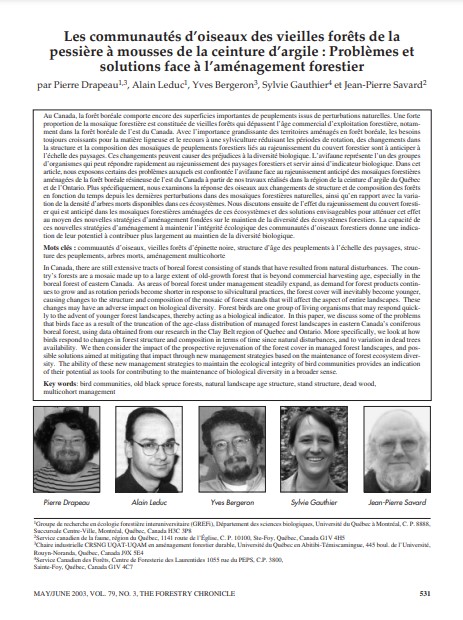Bird communities of old spruce-moss forests in the Clay Belt region: Problems and solutions in forest management
Bosque Modelo:
Lake Abitibi
Temática:
Gestión forestal
Tipo de documento:
Artículo científico
Resumen
In Canada, there are still extensive tracts of boreal forest consisting of stands that have resulted from natural disturbances. The country’s forests are a mosaic made up to a large extent of old-growth forest that is beyond commercial harvesting age, especially in the boreal forest of eastern Canada. As areas of boreal forest under management steadily expand, as demand for forest products continues to grow and as rotation periods become shorter in response to silvicultural practices, the forest cover will inevitably become younger, causing changes to the structure and composition of the mosaic of forest stands that will affect the aspect of entire landscapes. These changes may have an adverse impact on biological diversity. Forest birds are one group of living organisms that may respond quickly to the advent of younger forest landscapes, thereby acting as a biological indicator. In this paper, we discuss some of the problems that birds face as a result of the truncation of the age-class distribution of managed forest landscapes in eastern Canada’s coniferous boreal forest, using data obtained from our research in the Clay Belt region of Quebec and Ontario. More specifically, we look at how birds respond to changes in forest structure and composition in terms of time since natural disturbances, and to variation in dead trees availability. We then consider the impact of the prospective rejuvenation of the forest cover in managed forest landscapes, and possible solutions aimed at mitigating that impact through new management strategies based on the maintenance of forest ecosystem diversity. The ability of these new management strategies to maintain the ecological integrity of bird communities provides an indication of their potential as tools for contributing to the maintenance of biological diversity in a broader sense.
Información Bibliográfica
Autor:
Drapeau, P, A Leduc, Y Bergeron, S Gauthier and J-P Savard.
Revista:
Forestry Chronicle
Año:
2003
N°:
3
País :
Canadá
Páginas:
531 - 540
Volumen:
79
Idioma:
Ingles
Palabras claves
bird communities, old black spruce forests, natural landscape age structure, stand structure, dead wood, multicohort management





